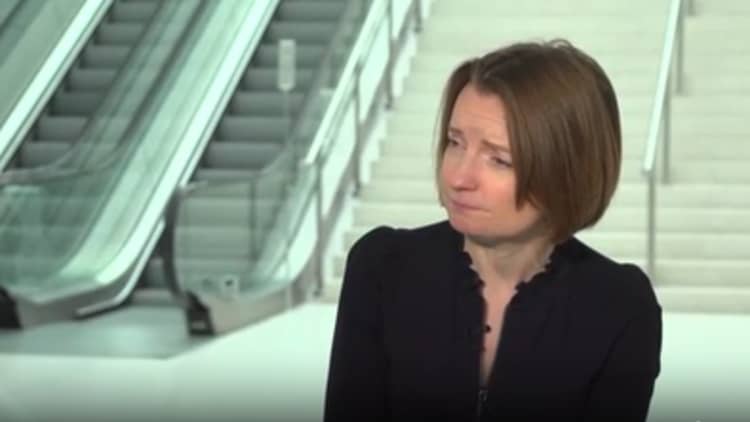
A pedestrian sheltering under an umbrella passes a Julius Baer Group Ltd. branch in Zurich, Switzerland, on Tuesday, July 13, 2021.
Stefan Wermuth | Bloomberg | Getty Images
The share price of Julius Baer plummeted after the Swiss private bank disclosed 606 million Swiss francs ($692.7 million) of loan exposure to a single conglomerate client.
The disclosure and swirling concerns about concentration of risk in the lender’s private debt business came against a backdrop of emerging news that troubled Austrian real estate group Signa was teetering. It filed for insolvency on Wednesday.
The 606 million Swiss franc exposure to one client — via three loans to different entities within a European conglomerate — is collateralized by commercial real estate and luxury retail, the company revealed. It represents around 18% of Julius Baer’s CET1 capital as of the end of June 2023, according to analysts at DBRS Morningstar.
The bank last week booked provisions of 70 million Swiss francs to cover the risk of a single borrower in its private loan book.
Despite the speculation, Julius Baer has not confirmed that the client is Signa, and a spokesperson told CNBC on Thursday that the bank “cannot comment on alleged or existing client relationships.”
DBRS Morningstar Senior Vice President Vitaline Yeterian and Managing Director Elisabeth Rudman on Wednesday said that such a large concentration of funds to a troubled real estate borrower raises concerns about risk management and highlights the broader risks for the banking sector, as highly leveraged companies grapple with higher debt financing costs in a perilous economic environment.
The European Central Bank recently examined the commercial real estate sector and the provisioning methods and capital buffers of European banks.
DBRS Morningstar says the capital levels of Julius Baer are adequate to absorb further losses, with a hypothetical 606 million Swiss franc loss accounting for around 280 basis points of the Swiss bank’s 15.5% CET1 ratio, based on risk-weighted assets of 21.43 billion Swiss francs as of the end of June.
“However, we see the recent significant fall in Julius Baer’s share price as a reminder of the rising impact of technology and social media on stakeholder behavior,” they said in Wednesday’s note.

“Meanwhile, the limited level of disclosure makes it hard to assess the full picture for the bank at this stage. Any kind of deposit outflow experienced by Julius Baer would be negative for the bank’s credit profile.”
Rickenbacher issued a statement on Monday confirming that the bank would maintain its dividend policy, along with other updates, while reassuring investors that any excess capital left at the end of the year will be distributed via a share buyback.
Julius Baer has a strong capital position with a CET1 capital ratio of 16.1% as of the end of October, the bank said Monday, significantly above its own floor of 11%.
Even under a hypothetical total loss scenario, the Group’s pro-forma CET1 capital ratio at Oct. 31 would have exceeded 14%, the bank said, meaning it would have remained “significantly profitable.”
“Julius Baer is very well capitalised and has been consistently profitable under all circumstances. We regret that a single exposure has led to the recent uncertainty for our stakeholders,” Rickenbacher said.
“Together with investing and multi-generational wealth planning, financing is an inherent part of the wealth management proposition to our clients.”

He added that the board is now reviewing its private debt business and the framework within which it is conducted.
Nonetheless, Julius Baer’s shares continued to fall and were down 18% on the year as of Thursday morning.
“We continue to closely monitor sectors that have come under stress as a result of more uncertain economic times, higher for longer interest rates, tightening in lending conditions, weaker demand, higher operating costs, and in particular the commercial real estate sector,” DBRS Morningstar’s Yeterian said.
Several economists in recent weeks have suggested that there are lingering vulnerabilities in the market that may be exposed in 2024, as the sharp rises in interest rates enacted by major central banks in the last two years feed through.
Exposure to commercial real estate emerged as a concern for several major lenders this year, while the risks associated with panic-driven bank runs on smaller lenders became starkly apparent in March, with the collapse of Silicon Valley Bank.
The ensuing ripple effects shook global investor and depositor confidence and eventually contributed to the downfall of Swiss giant Credit Suisse.
A common theme during the mass withdrawals of investment and customer deposits was a panic exacerbated by rumors about the lender’s financial health on social media, a trend bemoaned by its bosses at the time.







![What Is a Markup Language? [+ 7 Examples] What Is a Markup Language? [+ 7 Examples]](https://static.semrush.com/blog/uploads/media/82/c8/82c85ebca40c95d539cf4b766c9b98f8/markup-language-sm.png)